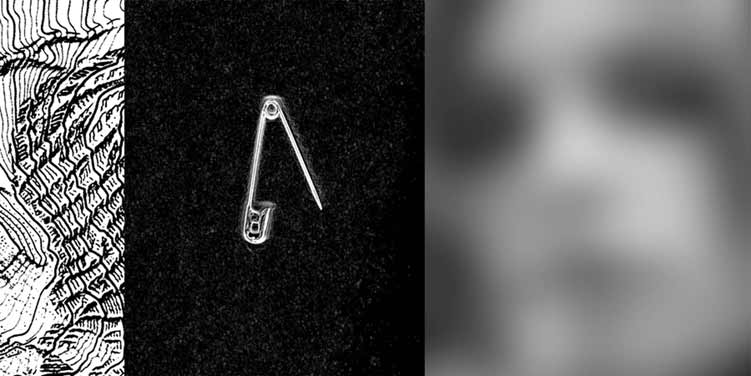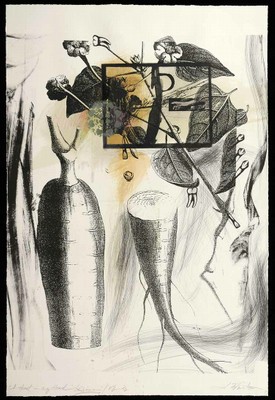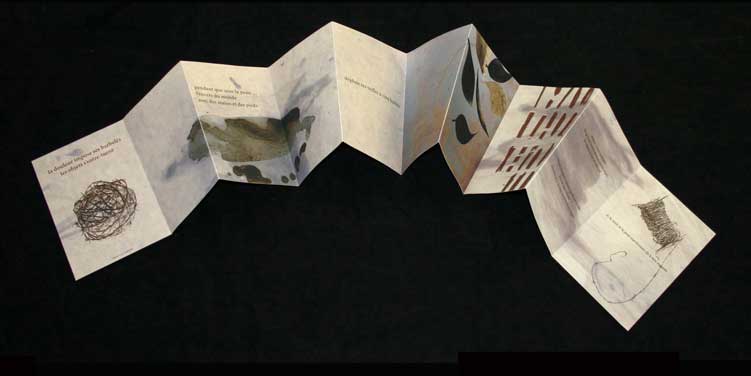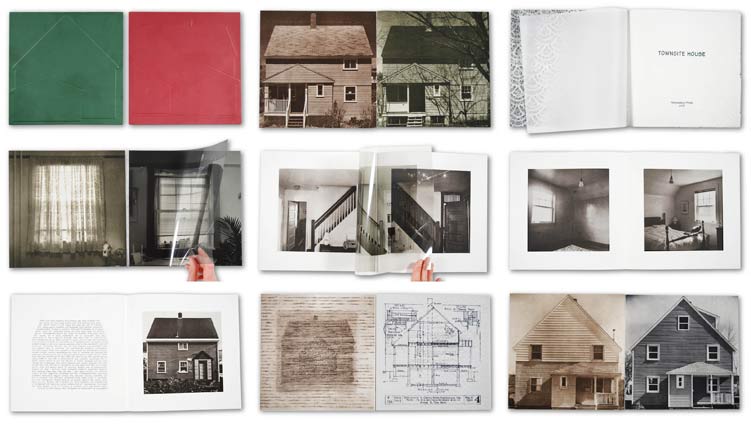12 October – 28 October 2007
What happens behind the eyes that scrutinize, question and observe? The intention of the artist functions in reaction to the immediate environment, daily life, memory and recollections. These occupy an indeterminate andindeterminable space in our minds, and leave behind an imprint that can stay buried in the depths of memory, but that can also re-emerge at any moment, leaving us with a sense of déjà-vu.
Five Canadian printmakers are gathered here around the same theme. They have in common to work with the mind, the memory and the forgotten. These artists have been chosen for the quality of their artistic approach, for the diversity of their technical propositions and for the particularity of their way of expression.
We can wander through the effluvia of our memories to appreciate the spirit of the space proposed by Marlène MacCallum. She has us penetrate interior spaces that question the notion of absence and intimacy. Derek Michaël Besant directs us towards the evanescent image of memories. He makes contact with objects that allow us to code, capture and preserve our perceived stimulations and information. The work of Guy Langevin is based on what remains of a gesture, a passage or a presence after they have been litterally forgotten. The title of this series accurately reflects this: “Parfum de mémoire”, or “The Scent of a Memory”. In the work of Jan Winton, the discourse deals with man’s cultural heritage, and the delicate interventions of the artist refer us to the body’s memories. My work explores life’s imbalances, and questions among other things our sense of isolation when we feel our memories slipping away. Our delusions and weakness are sought out, victims of the constraints of our imprisonments.
The choice of this theme is intended to be an invitation to penetrate to the very heart of the minds of the artists in order to impregnate your own memory. Even though the artists explore the subject in different ways, they have created ramifications between themselves and forged highly interesting links.
Jo Ann Lanneville, curator
Derek Michael Besant
Amnesia serie
Waterbased serigraphy on geotrans
Each image 60×120 cm
Derek Mikael Besant has turned to memory to illuminate the worlds of phenomenon and imagination, to open pathways between thought and feeling and our individual and collective experience. Perhaps, most importantly he is attempting to create a psychological and spirituel equilibrium that recognises the astonishing power and value of memory in human life.
Guy Langevin
SCENT OF MEMORY
My work is based on duality between fugitiveness of light and moment, and the perenniality of impressions people, situations and events make in our mind. As this duality, the work rocks between precision and blurry images. Haziness may be, sometimes, the more accurate way to express an idea. When the work speaks about human, or through the human image, it is important to have many level of reading. In my mind, that shows the complexity of life.
Duality does not mean contradiction. Memory and forgetfulness are both sides of the same medal, as life and death. They are indivisible. Light needs shadow to be really appreciated and remembrances, to be magnified, find in forgetfulness a perfect companion. Life, as memory, is fugitive.
Working mezzotint allows me to use light as the first component of my works. The process itself helps me to create and make deformation of image during the long time used to rock the plate. This process is not too long, it just takes time. This time is a working time, thinking time, so it is not wasted time. Mezzotint is not only a printmaking technique, it is a way of thinking images. I do practice mezzotint for almost 20 years, and throughout this time, it has influenced all the other things I have done. Is mezzotint a sickness? If yes, I am deeply affected.
“Scent of memory” is a 20 mezzotint works exhibition. Works are from different sizes, from 20 x 30 cm to 70 x 100 cm. This serial of works has been produced since 2002 and is still my main production, so, the number of works may increase to the time of exhibition.
Jan Winton
I use art as a means of filtering and reinterpreting just about everything that comes my way.
My work is divided between print making and painting with both having roots in drawing and
photography.. My visual research and sources incorporate an array of subjects.. . ..the human body,
botanical illustration, historical and contemporary photography, fabric design, architecture and maps. I try
to find the most interesting remixes of ideas /past and present. My compositions can include landscape,
floral elements, design elements and photographic essays on specific subjects.. .eg) parts of the body,
architectural detailing..etc. I work on paper, wood and canvas.
What is my work “about”?
Most simply stated my work seeks to set up and observe contrasts . I have sought out the symbolic to
explain meaning to myself for years, and see the world of objects and ideas as been inextricably linked. The
indivisibility and transference of meaning from “experience” into belief structures ( and back again) is a
virtually world wide and cross cultural experience. I want to explore how ideas grow from the most basic
bodily observations/ experiences into complex interpretations of what can be sought but maybe never
really proven . Perhaps I am talking about sensation and intuition. I know that I make art because I am not
content with accepting prescriptive authority, or primacy of assigned meaning. I think my art tries to
utilize the seductive qualities of “the beautiful”. . . .to dramatize or satirize situations, as well as to set upß
dramatic atmosphere in order to ask subtle questions about life and living. Finally I am not interested
really in posing answers for the viewer. I wish to draw them in and leave them with sensations and feelings
that are their own to ponder and I they wish to, think further about.
Jan Winton
2006
Jo Ann Lanneville
My work uses existing signs or else invents others, infusing them with new meaning. Through vegetable or geological anthropomorphic evocations, the omnipresence of shapes contained within a of barbed wire indicates a denominator common to the different aspects of human activity: a hidden and persistent malaise awaiting a remedy.
Using the analogy of a ball of barbed wire, thorny lines wind around the subjects of our imprisonment in fixed structures from which we cannot escape, in a cycle as endless as the world itself.
We can suppose the “Hand-Tree” to be a symbolic human type. The representation reminds us of a tree-trunk, uprooted and pruned, something nameless in the desert of the world. Surrounded by endless spirals, subjected to continuous constraints or even tortured, is there no shelter? Is this not the eternal cycle of falling and rising, highs and lows, of letting go? Are we like tree-trunks, unsupported and rootless?
Marlene MacCullum
Fotografiet är kanske i själva verket inget annat än en tröskel, en öppning och stängning – samtigt en hälsning och ett farväl. I varje instans förstör ljusinsläppet det den försöker minnas. Eduardo Cadava
… the photograph is itself perhaps nothing other than a threshold, an opening and closing – a greeting and farewell. In each instance, the gathering of light shatters what it seeks to remember. Eduardo Cadava
For this exhibition, I proposed a selection of work from the last ten years that explores how I have used the image of the window. From 1985-99 my home was the source for photographic explorations which were then translated into prints and book works. These works demonstrate an attraction to the residue and artifacts of daily life. In 2000 I expanded my imagery source to include a range of architectural types and the connotations created by other peoples’ homes, ruins, defunct industrial spaces, monuments and museums. Recently, I have returned to the observation and interpretation of the private domestic arena. I have consistently sought to create images that encapsulate the sensory and temporal paradoxes we experience in our architectural surroundings; to mirror the way in which our perception of a given interior is mitigated by our past experiences and memories of similar spaces. I am also motivated by observations of the bizarre or incongruous in the mundane and my desire to build an archive of these ephemeral experiences.
I find the window to be a particularly potent image theme. It speaks of the state of being “in between” and the process of transition from inside to outside. Windows are also the apertures for buildings. This to be a very appropriate metaphor for this thematic exhibition in the way it conjures up a series of parallel images; the window and the room, the lens and the camera, and the eye and the mind.
My chosen media plays a large role both in the way it translates the subject matter and in the effect of the presentation. Since 1994, I have been working with photogravure (héliogravure). The interaction of ink and paper have a tactile and physical presence while simultaneously evoking a state of photographic memory. In 1997, I introduced the book format and the use of text, and letterpress printing, into my practice. These texts and images explore issues along parallel paths, independently addressing similar content so as to generate associations rather than provide explanations. The binding and structure of the book works use the traditional book form as the basis but then subvert the conventions so that the physical and temporal experience of reading the book relates to the content.





